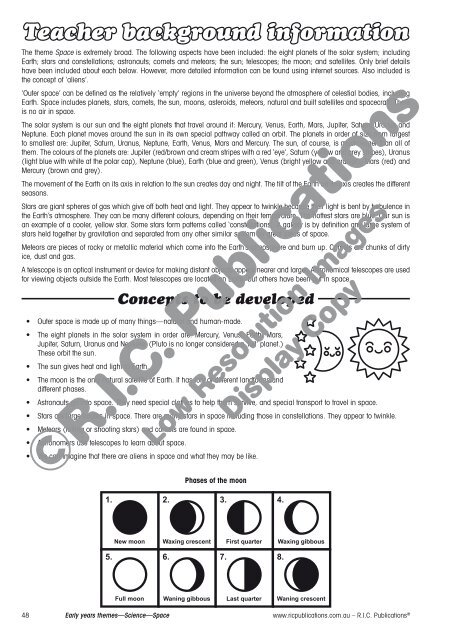RIC-20953 Early years Science - Space
Create successful ePaper yourself
Turn your PDF publications into a flip-book with our unique Google optimized e-Paper software.
Teacher background information<br />
The theme <strong>Space</strong> is extremely broad. The following aspects have been included: the eight planets of the solar system; including<br />
Earth; stars and constellations; astronauts; comets and meteors; the sun; telescopes; the moon; and satellites. Only brief details<br />
have been included about each below. However, more detailed information can be found using internet sources. Also included is<br />
the concept of ‘aliens’.<br />
‘Outer space’ can be defi ned as the relatively ‘empty’ regions in the universe beyond the atmosphere of celestial bodies, including<br />
Earth. <strong>Space</strong> includes planets, stars, comets, the sun, moons, asteroids, meteors, natural and built satellites and spacecraft. There<br />
is no air in space.<br />
The solar system is our sun and the eight planets that travel around it: Mercury, Venus, Earth, Mars, Jupiter, Saturn, Uranus and<br />
Neptune. Each planet moves around the sun in its own special pathway called an orbit. The planets in order of size from largest<br />
to smallest are: Jupiter, Saturn, Uranus, Neptune, Earth, Venus, Mars and Mercury. The sun, of course, is much larger than all of<br />
them. The colours of the planets are: Jupiter (red/brown and cream stripes with a red ‘eye’, Saturn (yellow and grey stripes), Uranus<br />
(light blue with white at the polar cap), Neptune (blue), Earth (blue and green), Venus (bright yellow and orange), Mars (red) and<br />
Mercury (brown and grey).<br />
The movement of the Earth on its axis in relation to the sun creates day and night. The tilt of the Earth on its axis creates the different<br />
seasons.<br />
Stars are giant spheres of gas which give off both heat and light. They appear to twinkle because their light is bent by turbulence in<br />
the Earth’s atmosphere. They can be many different colours, depending on their temperature. The hottest stars are blue. Our sun is<br />
an example of a cooler, yellow star. Some stars form patterns called ‘constellations’. A galaxy is by defi nition any large system of<br />
stars held together by gravitation and separated from any other similar system by great areas of space.<br />
Meteors are pieces of rocky or metallic material which come into the Earth’s atmosphere and burn up. Comets are chunks of dirty<br />
ice, dust and gas.<br />
A telescope is an optical instrument or device for making distant objects appear nearer and larger. Astronomical telescopes are used<br />
for viewing objects outside the Earth. Most telescopes are located on Earth, but others have been put in space.<br />
Concepts to be developed<br />
• Outer space is made up of many things—natural and human-made.<br />
• The eight planets in the solar system in order are: Mercury, Venus, Earth, Mars,<br />
Jupiter, Saturn, Uranus and Neptune. (Pluto is no longer considered a ‘full’ planet.)<br />
These orbit the sun.<br />
• The sun gives heat and light to Earth.<br />
• The moon is the only natural satellite of Earth. It has lots of different landforms and<br />
different phases.<br />
• Astronauts go into space. They need special clothes to help them survive, and special transport to travel in space.<br />
• Stars are large bodies in space. There are many stars in space including those in constellations. They appear to twinkle.<br />
• Meteors (falling or shooting stars) and comets are found in space.<br />
• Astronomers use telescopes to learn about space.<br />
• We can imagine that there are aliens in space and what they may be like.<br />
Phases of the moon<br />
1.<br />
2.<br />
3.<br />
4.<br />
New moon<br />
Waxing crescent<br />
First quarter<br />
Waxing gibbous<br />
5.<br />
6.<br />
7.<br />
8.<br />
Full moon<br />
Waning gibbous<br />
Last quarter<br />
Waning crescent<br />
48 <strong>Early</strong> <strong>years</strong> themes—<strong>Science</strong>—<strong>Space</strong> www.ricpublications.com.au – R.I.C. Publications ®


















